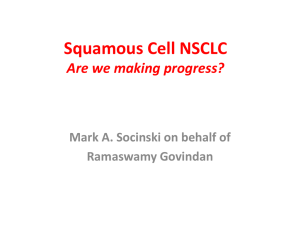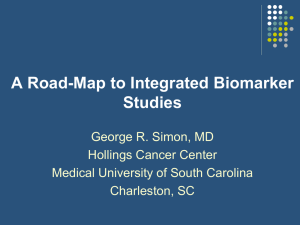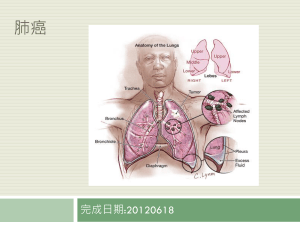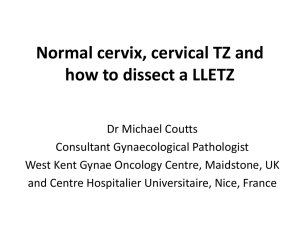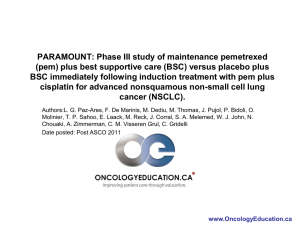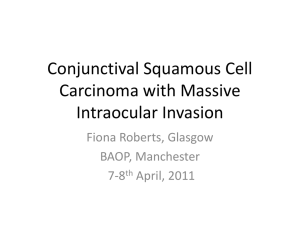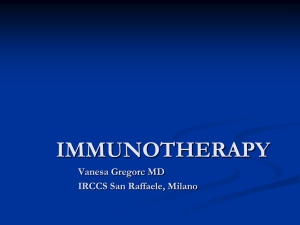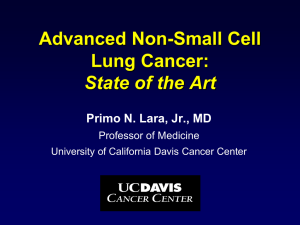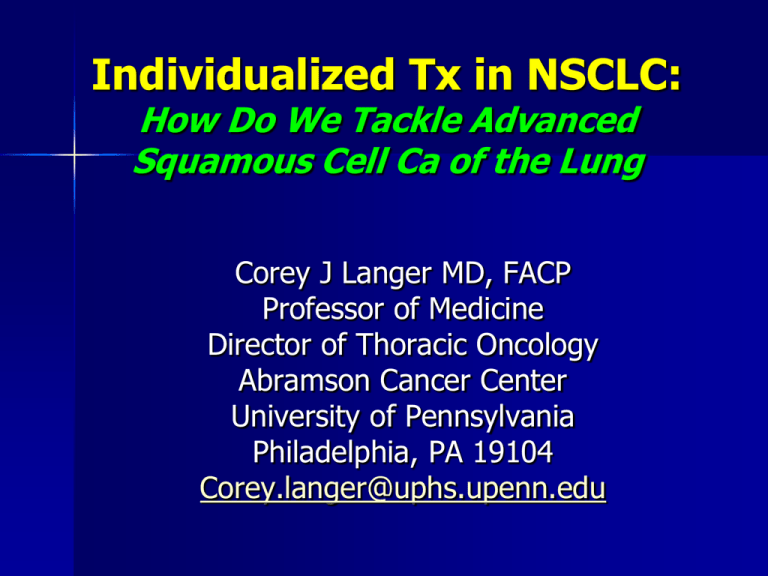
Individualized Tx in NSCLC:
How Do We Tackle Advanced
Squamous Cell Ca of the Lung
Corey J Langer MD, FACP
Professor of Medicine
Director of Thoracic Oncology
Abramson Cancer Center
University of Pennsylvania
Philadelphia, PA 19104
Corey.langer@uphs.upenn.edu
Disclosures
Grant/Research Support:
– Bristol Myers Squibb, Pfizer, Imclone, Lilly, ScheringPlough Research Institute, Sanofi-Aventis, Amgen, Cell
Therapeutics Inc., OrthoBiotech, Celgene, Vertex,
Genentech, OSI, AstraZeneca, Pfizer, Active Biothech,
Medimmune
Scientific Advisor:
– Bristol Myers Squibb, Imclone, Sanofi-Aventis, PfizerPharmacia, Intrabiotics, GlaxoSmithKline, Pharmacyclics,
Amgen, AstraZeneca, Novartis, Genentech, OSI,
Savient, Bayer/Onyx, Abraxis, Clarient, Synta
Speakers Bureau: curtailed as of 12/10
– Bristol Myers Squibb, Imclone, Sanofi- Aventis, Lilly,
OrthoBiotech, Genentech, OSI
Lung Cancer
In 2010, ~213,380 new cases and ~160,390 deaths are
predicted in the United States
Second most common cancer in men and women and
leading cause of cancer deaths
Accounts for more deaths than breast, colon and prostate
cancer combined
Unfavorable stage distribution at the time of diagnosis
Types of lung cancer
– Non–small cell lung cancer (NSCLC): 87%
1/2 to 2/3 adenoca
1/3+ squamous and other histologies
– Small cell lung cancer (SCLC): 13%
Cancer Facts and Figures 2007. Atlanta, GA: American Cancer Society; 2007.
Non-small Cell Lung cancer
Adenocarcinoma
–Glandular pattern
WHO
–Mucin positivity (50%)
–CK7+/CK20Common, but not 100%
–TTF-1+ (75%)
Squamous cell carcinoma
–Cellular keratinization
WHO
–Intercellular bridges
–Keratin “pearl” formation
–CK7-/CK20Common,
but not 100%
–TTF-1 neg
–P63 or p40+ or CK5/6+
Histologic Distinctions in NSCLC
Squamous:
–
–
–
–
–
More central presentation
Higher incidence of locoregional recurrence
Decreased incidence of metastatic spread
Relatively more common in men, Eastern Europe, smokers
Declining incidence overall
Adenocarcinoma:
–
–
–
–
More often peripheral
Higher incidence of metastatic spread
Less profound link with tobacco use
Increasing incidence; relatively more common in women
Therapeutic Implications
Histologic Prism
Tendency until 2005 to “lump” NSCLC histologies
– Little difference in Tx outcome
Therapeutic Empiricism
– Increasing NOS designation
Insufficient tissue
Pathologic “laziness”
ECOG 1594: Overall Survival
by Treatment Group
1207 patients, stage IIIB/IV :(15/85%), PS 0–2; Median age 63, M/F (64/36%)
Schiller JH et al. NEJM. 2002;346(2):92-98.
Therapeutic Implications
Histologic Prism
Tendency until 2005 to “lump” NSCLC histologies
– Little difference in Tx outcome
Therapeutic Empiricism
– Increasing NOS designation
Insufficient tissue
Pathologic “laziness”
Since 2004, histology and molecular fingerprints have become
ascendant
– Tx restrictions and risk: bevacizumab
– Histologic Variations in outcome
Adenocarcinoma: better outcome with EGFr TKI, pemetrexed
– Province of Actionable molecular markers [EGFR; ALK; ROS-1, etc
Therapeutic Implications
Histologic Prism
Tendency until 2005 to “lump” NSCLC histologies
– Little difference in Tx outcome
Therapeutic Empiricism
– Increasing NOS designation
Insufficient tissue
Pathologic “laziness”
Since 2004, histology and molecular fingerprints have become
ascendant
– Tx restrictions and risk: bevacizumab
– Histologic Variations in outcome
Adenocarcinoma: better outcome with EGFr TKI, pemetrexed
– Province of Actionable molecular markers [EGFR; ALK; ROS-1, etc
Squamous ca: tendency for better outcome
–
–
–
–
gemcitabine vs pemetrexed
Nab-paclitaxel vs standard paclitaxel (RR%)
Immunologic Tx: Ipilimumab; PD1
FGFR and PI3K as targets: still investigational
An Evolving View of Adenocarcinoma
Emergence of “Actionable” Molecular Markers
2014
2000
KRAS
Pending
EGFR
BRAF
MEK
PIK3CA
ROS1
HER2
EML4-ALK
An Evolving View of Squamous Cell Ca
Emergence of “Actionable” Molecular Markers
2000
2014
An Evolving View of Squamous Cell Ca
Emergence of “Actionable” Molecular Markers
2000
2014
Squamous Cell Ca:
Wallflower at the Dance
Safety Signals:
Bevacizumab
Lack of Efficacy: Pemetrexed
Lack of Actionable Molecular Markers:
Rand Phase II: Bevacizumab +
Paclitaxel/Carboplatin in Advanced NSCLC
Paclitaxel 200 mg/m2
carboplatin AUC 6
(PC) q3w × 6
Progression of
disease*
* Crossover to 15 mg/kg q3w
bevacizumab allowed
Previously untreated
metastatic NSCLC
(N=98)
PC × 6
+ bevacizumab
7.5 mg/kg q3w
Bevacizumab
7.5 mg/kg q3w to PD or
unacceptable toxicity
Excluded:
CNS metastasis
On therapeutic
anticoagulation
PC × 6
+ bevacizumab
15 mg/kg q3w
Bevacizumab
15 mg/kg q3w to PD or
unacceptable toxicity
Objectives = time to progression, response, survival, and safety
1. Johnson et al. J Clin Oncol. 2004;22:2184–2191.
Randomized Phase II Trial:
Pulmonary Bleeding
6 cases of severe or fatal pulmonary hemorrhage
– 4 (31%) of 13 bevacizumab-treated patients with squamous cell
histology
– 2 (4%) of 53 bevacizumab-treated patients with histology other than
squamous cell
Patients receiving chemotherapy alone (N=32) had no pulmonary
hemorrhages
On the basis of this analysis, squamous cell histology and
bevacizumab therapy were identified as risk factors for pulmonary
hemorrhage
These phase II data were used to design the phase III trial
exclusion criteria [squamous histology has been excluded ever since]
1. Johnson et al. J Clin Oncol. 2004;22:2184–2191.
Study Design
Stage IIIB/IV
NSCLC
PS 0 - 1
No prior chemo
Randomization:
gender, PS, stage,
histo vs cyto dx,
brain mets
Pemetrexed 500 mg/m2 +
Cisplatin 75 mg/m2 day 1
R
Primary objective: Overall Survival
15% Non-inferiority margin (HR 1.17)
N = 1700 Patients , Power 80%
Gemcitabine 1250 mg/m2 days 1 + 8
Cisplatin 75 mg/m2 day 1;
B12, folate, and dexamethasone given in both arms
Scagliotti GV et al. JCO 2008; 26:3543
TS Expression Levels Are Higher in
Squamous Versus Adenocarcinoma
“May be useful in
selecting patients with
NSCLC who should
receive treatment with
TS-inhibiting agents”
Ceppi, P et al. Cancer 107:1589,
2006
Phase III Trial: Cisplatin/Pemetrexed vs
Cisplatin/Gemcitabine - Overall Survival in Patients with
Adenocarcinoma or Large Cell Ca -
Second -Line Study of Pemetrexed vs.
Docetaxel : Efficacy by Histology
Non-squamous group
Squamous group
Pemetrexed
(n=205)
Docetaxel
(n=194)
Pemetrexed
(n=78)
Docetaxel
(n=94)
% ECOG PS 2
12.5
10.1
8.3
17.4
% TSPC <3 months
51.0
51.0
48.7
41.9
% Stage IV
81.5
78.9
57.7
66.0
% Male
60.5
69.1
89.7
88.3
Median OS, months
9.3
8.0
6.2
7.4
Adjusted OS HR (95% CI)
0.778 (0.607, 0.997)
1.563 (1.079, 2.264)
Median PFS, months
Adjusted PFS HR (95% CI)
3.1
3.0
0.823 (0.664, 1.020)
2.3
2.7
1.403 (1.006, 1.957)
Treatment by Histology Interaction: Survival Adjusted for Cofactors (p=0.001)
Peterson P. et al. 12th World Conference on Lung Cancer 2007
Progression-free Survival by Histology
JMEN Switch Maintenance Trial
Progression-free Probability
Non-squamous
Squamous
HR=1.03 (95% CI: 0.77-1.5)
P =0.896
HR=0.47 (95% CI: 0.37-0.6)
P <0.00001
1.0
0.9
0.8
0.7
0.6
0.5
0.4
0.3
0.2
0.1
0.0
1.0
0.9
0.8
0.7
0.6
0.5
0.4
0.3
0.2
0.1
0.0
Pemetrexed 4.4 mos
Placebo
1.8 mos
0
3
6
9
12
15
Time (months)
18
21
24
Pemetrexed 2.4 mos
Placebo
2.5 mos
0
3
6
9
12
15
Time (months)
18
21
24
Overall Survival by Histology
JMEN Switch Maintenance Trial
Non-squamous (n=481)
Squamous (n=182)
HR=1.07 (95% CI: 0.49–0.73)
P =0.678
HR=0.70 (95% CI: 0.56-0.88)
P =0.002
Survival Probability
1.0
0.9
1.0
0.8
0.9
0.7
0.8
0.7
0.6
Pemetrexed 15.5 mos
0.5
0.6
Pemetrexed 9.9 mos
0.5
0.4
0.4
0.3
Placebo
10.3 mos
0.2
0.1
0.3 Placebo
0.2 10.8 mos
0.1
0.0
0
3
6
9 12 15 18 21 24 27 30 33 36 39 42 45 48
Time (months)
0.0
0
3
6
9
12 15 18 21 24 27 30 33 36 39 42 45 48
Time (months)
Advanced NSCLC with
Squamous Histology
Disappointments to date have not
prevented us from targeting this
group of pts in ongoing, empiric trials
ECOG 4508: RP2
Non-Bev Eligible
CTEP E4508
All histology
• NSCLC
• 1st line
1
Carboplatin / Paclitaxel / Cetuximab
Cetux
1
Carboplatin / Paclitaxel / A12
A12
1
Carboplatin / Paclitaxel / Cetuximab / A12
Cetux / A12
PI: N. Hanna (ECOG)
PFS
N=225
ECOG 4508: RP2
Non-Bev Eligible
CTEP E4508
All histology
• NSCLC
• 1st line
1
Carboplatin / Paclitaxel / Cetuximab
Cetux
1
Carboplatin / Paclitaxel / A12
A12
1
Carboplatin / Paclitaxel / Cetuximab / A12
Cetux / A12
PI: N. Hanna (ECOG)
PFS
N=225
Suspended because of untoward toxicity
in both Cetuximab arms, including an
increased rate of grade 5 toxicity
ESCAPE - Phase III Trial Comparing
Carboplatin and Paclitaxel +/Sorafenib in NSCLC
Chemotherapy phase
n=900
Stratification:
Geographic region
ECOG PS 0 vs 1
Squamous vs
non-squamous cell
Stage IIIb (with
effusion) vs Stage IV
R
A
N
D
O
M
I
Z
E
Maintenance
phase
Carboplatin AUC 6 d1 +
Paclitaxel 200 mg/m2 d1 +
Sorafenib 400 mg bid d2-19,
q3w (CPS)
Sorafenib
400 mg
bid
Carboplatin AUC 6 d1 +
Paclitaxel 200 mg/m2 d1 +
Placebo d2-19, q3w (CPP)
Placebo
Scagliotti GV et al. Proc ESMO/IASLC 2008
Overall Survival by Histology
Squamous Cell
CPS
Median: 8.9 months
95% CI: 6.1, 13.9
CPP
Median: 13.6 months
95% CI: 9.6, —
1.00
Survival Probability
Survival Probability
1.00
Non-Squamous Cell
0.75
0.50
0.25
CPS
Median: 11.5 months
95% CI: 9.7, 14.8
CPP
Median: 10.3 months
95% CI: 9.3, 11.5
0.75
0.50
0.25
HR = 0.98
95% CI: 0.78, 1.24
HR = 1.81
95% CI: 1.19, 2.74
0
0
4
Patients at Risk
CPS 107
73
CPP 112
97
8
12
16
Months
24
41
9
12
2
3
20
0
0
4
Patients at Risk
CPS 357
281
CPP 350
280
8
12
16
20
Months
173
168
38
22
5
2
Scagliotti GV et al. Proc ESMO/IASLC 2008
Study A1016: Phase III Study of Carboplatin
+ Paclitaxel +/- Figitumumab in 1st Line NSCLC
of non-adenocarcinoma histology
Trial Design
Multi-center,
randomized,
open-label
Endpoints
Stratification
Primary: OS
Secondary: PFS, ORR,
Safety, QoL, biomarkers,
pharmacoeconomics
Key Entry Criteria
● Other than Adenoca
● Brain mets allowed
● Adjuvant > 12 month prior
• Gender
• Histology
(Sq vs non-Sq)
• Prior Adj Chemo (Y/N)
Study
Sites
FSFV
Global
2Q08
R
A
N
D
O
M
I
Z
E
Figitumumab (20 mg/kg)
Paclitaxel
Carboplatin
N=820
N = 410
N = 410
Paclitaxel
Carboplatin
Overall Survival
% Probability of Survival
PC
Event Total 1y OS 2yr OS
mOS = 10.3 mo
PCF
184
342
34%
17%
PC
165
339
39%
20%
PCF
mOS = 8.5 mo
HR (95%CI):1.23 (1.0,1.5), p=0.051
Months
ECLIPSE Study Overview
N= 825
International, Open-label
Gemcitabine + Carboplatin
Patient Population:
• Advanced squamous cell
carcinoma
R
Endpoints:
Primary: OS
Secondary: PFS, TTP, ORR,
safety/tolerability, QoL
Doses:
Gemcitabine 1000 mg/m2 D 1 & 8 q3wk
Carboplatin AUC 5 D1 q3wk;
Iniparib 5.6 mg/kg IV D 1, 4, 8 & 11 q3wk
1:1
• Patients restaged by CT scans (per RECIST 1.1
version) q 2 cycles (6 wks)
• Patients may remain on study regimen after 6
cycles if there is no evidence of PD or the presence
of DLTs
Gemcitabine + Carboplatin
+ iniparib
First Patient Enrolled: March 5, 2010
29
ECLIPSE Study Overview
N= 825
International, Open-label
Gemcitabine + Carboplatin
Patient Population:
• Advanced squamous cell
carcinoma
R
Endpoints:
Primary: OS
Secondary: PFS, TTP, ORR,
safety/tolerability, QoL
Doses:
Gemcitabine 1000 mg/m2 D 1 & 8 q3wk
Carboplatin AUC 5 D1 q3wk;
Iniparib 5.6 mg/kg IV D 1, 4, 8 & 11 q3wk
1:1
• Patients restaged by CT scans (per RECIST 1.1
version) q 2 cycles (6 wks)
• Patients may remain on study regimen after 6
cycles if there is no evidence of PD or the presence
of DLTs
Gemcitabine + Carboplatin
+ iniparib
First Patient Enrolled: March 5, 2010
30
Is there any hope for
patients with squamous
cell histology?
Pemetrexed Plus Cisplatin in 1st-line: Survival with
Gemcitabine/Cisplatin for Patients with Squamous Cell
Carcinoma
1.0
Pemetrexed + cisplatin
Survival probability
0.9
0.8
Median OS
(95% CI)
0.7
Adjusted HRa,b,c
(95% CI)
Gemcitabine + cisplatin
(N=244)
(N=229)
9.4 mos
10.8 mos
(8.4-10.2)
(9.5-12.1)
1.23
(1.00-1.51)
0.6
0.5
0.4
0.3
0.2
0.1
0
6
12
18
Survival time (months)
Scagliotti GV et al: J Clin Oncol. 26 (21), 2008: 3543-3551.
24
30
Second -Line Study of Pemetrexed vs.
Docetaxel : Efficacy by Histology
Non-squamous group
Squamous group
Pemetrexed
(n=205)
Docetaxel
(n=194)
Pemetrexed
(n=78)
Docetaxel
(n=94)
% ECOG PS 2
12.5
10.1
8.3
17.4
% TSPC <3 months
51.0
51.0
48.7
41.9
% Stage IV
81.5
78.9
57.7
66.0
% Male
60.5
69.1
89.7
88.3
Median OS, months
9.3
8.0
6.2
7.4
Adjusted OS HR (95% CI)
0.778 (0.607, 0.997)
1.563 (1.079, 2.264)
Median PFS, months
Adjusted PFS HR (95% CI)
3.1
3.0
0.823 (0.664, 1.020)
2.3
2.7
1.403 (1.006, 1.957)
Treatment by Histology Interaction: Survival Adjusted for Cofactors (p=0.001)
Peterson P. et al. 12th World Conference on Lung Cancer 2007
Phase III nab-P/C vs P/C
Study Design
nab-Paclitaxel 100 mg/m2 d1, 8 15
Chemo-naive
PS 0-1
Stage IIIb/IV
NSCLC
N = 1,050
Carboplatin AUC 6 d1
No Premedication
n = 525
1:1
Stratification factors:
Stage (IIIb vs IV)
Age (<70 vs >70)
Sex
Histology (squamous vs nonsquamous)
Geographic region
Paclitaxel 200 mg/m2 d1
Carboplatin AUC 6 d1
With Premedication of
Dexamethasone + Antihistamines
n = 525
Socinski et al 2010, ASCO
Objective Responses by Histology*
Response Rate (%)
50%
40%
P < 0.001
RR =1.680
Ab-P/C
P = 0.808
RR=1.034
P/C
41%
30%
24%
20%
26%
25%
Interaction pValue for
Histology: 0.036
10%
0%
Squamous
Histology
n = 228
* Not a pre-specified subgroup analysis
n = 221
Non-Squamous
Histology
n = 292
n = 310
PFS – ITT Population
1.00
Proportion Not Progressed
N/Events
Median PFS
(mo)*
0.75
95% CI
Nab-P/
Carbo
Paclitaxel/
Carbo
521/297
531/312
6.3
5.6-7.0
HR
P-Value
5.8
0.902
0.214
5.6-6.7
0.767-1.060
* PFS based on Independent assessment
0.50
Ab-P/carboplatin (N=521)
paclitaxel/carboplatin (N=531)
0.25
0.00
Pt at risk
Ab-P
P
0
3
6
9
12
15
18
21
24
27
30
521
531
330
321
167
162
86
75
38
48
23
19
10
10
4
4
0
2
0
1
0
0
Months
33
Overall Survival – ITT Population
1.00
Probability of Survival
N/Events
Median OS
(mos)
0.75
95% CI
NabP/Carbo
Paclitaxel/
Carbo
521/360
531/384
12.1
10.8-12.9
HR
P-Value
11.2
0.922
0.271
10.3-12.6
0.797-1.066
0.50
0.25
Ab-P/carboplatin (N=521)
Paclitaxel/carboplatin (N=531)
0.00
Pt at risk
Ab-P
Pac
0
3
6
9
12
15
18
21
24
27
30
33
521
531
469
470
381
389
313
308
246
243
200
191
163
148
98
89
23
24
0
5
0
1
0
0
Months
Secondary Endpoint: OS
Median PFS (mo)
ab-P/C
P/C
Events / N
HR
744 / 1052
0.922
12.1
11.2
Japan
86 / 149
0.950
16.7
17.2
Russia/Ukraine
521 / 724
1.019
11.0
11.1
North America
127 / 165
0.622
12.7
9.8
Male
589 / 789
0.894
11.4
10.0
Female
155 / 263
0.995
16.8
16.0
<70 yrs
639 / 896
0.999
11.4
11.3
70 yrs
105 / 156
0.583
19.9
10.4
Squamous
343 / 450
0.890
10.7
9.5
Nonsquamous
401 / 602
0.950
13.1
13.0
Stage IIIB
142 / 218
0.896
12.4
13.6
Stage IV
602 / 834
0.917
12.0
11.0
All patients
0.0
0.5
Favors ab-P/C
1.0
1.5
2.0
Secondary Endpoint: OS
Median PFS (mo)
ab-P/C
P/C
Events / N
HR
744 / 1052
0.922
12.1
11.2
Japan
86 / 149
0.950
16.7
17.2
Russia/Ukraine
521 / 724
1.019
11.0
11.1
North America
127 / 165
0.622
12.7
9.8
Male
589 / 789
0.894
11.4
10.0
Female
155 / 263
0.995
16.8
16.0
<70 yrs
639 / 896
0.999
11.4
11.3
70 yrs
105 / 156
0.583
19.9
10.4
Squamous
343 / 450
0.890
10.7
9.5
Nonsquamous
401 / 602
0.950
13.1
13.0
Stage IIIB
142 / 218
0.896
12.4
13.6
Stage IV
602 / 834
0.917
12.0
11.0
All patients
0.0
0.5
Favors ab-P/C
1.0
1.5
2.0
Chinese Trial: RP2
NCI CTG 01236716; PI: Wu Yilong
R
A
N
D
O
M
I
Z
E
Gemcitabine
Carboplatin
Nab-Paclitaxel
Carboplatin
•Restricted to Tx-naïve advanced
NSCLC with squamous histology
•N= 120; started 11/10
Ipilimumab and NSCLC histology, WCLC 2011, Abstr 701
Efficacy in Total NSCLC Population
Control
Pbo+ Chemo
(n=66)
Concurrent
IPI+ Chemo
(n=70)
Phased
IPI+ Chemo
(n=68)
4.6
5.5
5.7
----
HR = 0.81
P = 0.13
HR = 0.72
P = 0.05*
4.2
4.1
5.1
----
HR = 0.88
P = 0.25
HR = 0.69
P = 0.02*
8.3
9.7
12.2
----
HR = 0.99
P = 0.48
HR = 0.87
P = 0.23
irBORR
18%
21%
32%
mWHO-BORR
14%
21%
32%
Response
irPFS, median mo
mWHO-PFS, median
mo
OS, median mo
*Statistically significant per protocol-stipulated one-sided = 0.1; P values not adjusted for multiple
comparisons
irPFS, PFS by immune-related response criteria (irRC); irBORR, best overall response rate by irRC; mWHOPFS,
41 PFS by modified WHO criteria (mWHO); mWHO-BORR, best overall response rate by mWHO
Ipilimumab and NSCLC histology, WCLC 2011, Abstr 701
Activity of Phased-Ipilimumab by Baseline Histology
Phased vs. Control
Response
irPFS
mWHO-PFS
OS
Patient group
Events/PatientsHR (95% CI)
All
Non-Squamous
Squamous
54/68 vs 56/66
0.72 (0.50-1.06)
36/47 vs 41/51
0.82 (0.52-1.28)
18/21 vs 15/15
0.55 (0.27-1.12)
All
Non-Squamous
Squamous
All
Non-Squamous
Squamous
56/68 vs 61/66
0.69 (0.48-1.00)
37/47 vs 46/51
0.81 (0.53-1.26)
19/21 vs 15/15
0.40 (0.18-0.87)
51/68 vs 51/66
0.87 (0.59-1.28)
38/47 vs 37/51
1.17 (0.74-1.86)
13/21 vs 14/15
0.48 (0.22-1.03)
0.5 1 1.5
HR and 95% CI
Favors
Phased-Ipi
Control
In the Phased-Ipilimumab arm, improvements in irPFS, mWHO-PFS and OS vs. Control
appeared greater for squamous histology than for non-squamous
42Small sample size warrants caution in interpretation
Ipilimumab and NSCLC histology, WCLC 2011, Abstr 701
Activity of Phased-Ipilimumab by Baseline Histology
Phased vs. Control
Response
irPFS
mWHO-PFS
OS
Patient group
Events/PatientsHR (95% CI)
All
Non-Squamous
Squamous
54/68 vs 56/66
0.72 (0.50-1.06)
36/47 vs 41/51
0.82 (0.52-1.28)
18/21 vs 15/15
0.55 (0.27-1.12)
All
Non-Squamous
Squamous
All
Non-Squamous
Squamous
56/68 vs 61/66
0.69 (0.48-1.00)
37/47 vs 46/51
0.81 (0.53-1.26)
19/21 vs 15/15
0.40 (0.18-0.87)
51/68 vs 51/66
0.87 (0.59-1.28)
38/47 vs 37/51
1.17 (0.74-1.86)
13/21 vs 14/15
0.48 (0.22-1.03)
0.5 1 1.5
HR and 95% CI
Favors
Phased-Ipi
Control
In the Phased-Ipilimumab arm, improvements in irPFS, mWHO-PFS and OS vs. Control
appeared greater for squamous histology than for non-squamous
43Small sample size warrants caution in interpretation
Ipilimumab and NSCLC histology, WCLC 2011, Abstr 701
OS: Squamous NSCLC Subset
1.0
Proportion Alive
Regimen
0.8
Control
Concurrent
Phased
0.6
Events/
Patients
Median mo
HR
14/15
17/21
13/21
7.9
6.2
10.9
-1.02
0.48
0.4
0.2
0.0
0
Patients at risk
Concurrent 21
Phased
21
Control
15
44
3
6
9
12
15
18
21
24
27
13
19
11
11
15
10
6
12
7
4
9
4
3
9
1
3
8
1
2
5
1
0
3
0
0
0
0
Months
Phase 3 Trial Comparing Ipilimumab Plus Paclitaxel and Carboplatin Versus
Placebo Plus Paclitaxel and Carboplatin in Squamous NSCLC (CA184104/NCT01285609)
Phase 3 Trial
Squamous cell NSCLC or
Stage IV or recurrent NSCLC
N=920
Primary Endpoint
•OS
Secondary Endpoints
IPI 10 mg/kg IV
Q3W x 4 doses
Q12W from W24
PBO IV
Q3W x 4 doses
Q12W from W24
PAC 175 mg/m² IV
Q3W x 6 doses
PAC 175 mg/m² IV
Q3 W x 6 doses
CARB AUC 6 IV
Q3W x 6 doses
CARB AUC 6 IV
Q3W x 6 doses
Treat until progression or
unacceptable toxicity
Overall Survival (OS)
•OS in pts that receive one dose of blinded
therapy
•PFS
•BORR
Key Eligibility Criteria
•≥ 18 years of age
•Squamous cell NSCLC
•Stage IV or recurrent NSCLC
•ECOG PS ≤ 1
•No brain metastases or autoimmune
disease
Start Date: August 2011
Estimated Study Completion Date: June 2016
Estimated Primary Completion Date: September 2014
Status: Recruiting
Study Director: BMS
BORR, Best overall response rate; CARB, Carboplatin; ECOG PS, Eastern Cooperative Oncology Group Performance Status;
IPI, ipilimumab; OS, Overall survival; PAC, Paclitaxel; PFS, Progression-free survival; PBO, Placebo; W, Week
Actionable Targets in
Lung Adenocarcinomas
1999
2004
2005-2014
Unknown
KRAS
Unknown
75%
KRAS
35%
Unknown
60%
EGFR
RET
EGFR
ROS1
MEK
HER2
ALK
MET
BRAF
PIK3CA
Kris M et al. IASLC 2012 Targeted Therapies Conference
Actionable Targets ? in
Squamous Cell Lung Cancers
1999
2004-2010
2014
FGFR1
Unknown
100%
Unknown
100%
Unknown
50%
amplification
PIK3CA
mutation
PTEN
mutation
PTEN
loss
Okudela et al. Cancer Res 2008
Yamamoto et al. Pathol Int 2007
Weiss et al. Sci Transl Med 2010
Hammerman et al. Cancer Discovery 2011
TCGA Nature 2012
DDR2 mutation
2002-2012 – Changes in the
therapeutic landscape of stage IV
lung cancer
Target
FGFR1
amplification
25%
Unknown
37%
PTEN
mutation
17%
DDR2
mutation
0% KRAS
mutation
2%
PIK3CA
mutation
8%
PTEN loss,
complete
11%
N
Frequency
95% CI
FGFR1
amplification
13/52
25%
15–38%
PTEN mutation
3/18
17%
5–37%
complete
3/27
11%
3–26%
PIK3CA mutation
4/52
8%
2–17%
KRAS mutation
1/52
2%
1–9%
DDR2 mutation
0/18
0%
0–15%
PTEN loss,
Paik et al. J Clin Oncol 30: 2012 (suppl; abstr 7505)
Novel Therapeutic Targets
FGFR1 amplification
NFE2L2 oxidative stress pathway
DDR2 mutations
PI3K pathway
EGFR
FGFR1 AMPLIFICATION
Chromosomal gain is common
FGFR1 amplification
Amplification (FGFR1:CEP8 ≥ 2)
– 16-25%
Correlation with protein expression unknown
TCGA Nature 2012
Paik ASCO 2012
Heist J Thorac Oncol 2012
FGFR1 amplification in
squamous cell lung carcinoma
Definition of
amplification
%
amplified
%
polysomy
(if
available)
FISH
Median of 6 or more
gene copies
6.9
43/94
I–IV
FISH
Mean of 6 or more
gene copies
8.3
-
Squamous
I–IV
Quantitative
PCR
Predicted CNV of ≥2
in ≥1 exon
24.4
-
Squamous
I–IV
FISH
Copy number >2 and
<9 (low); >9 (high)
25.2
-
No of
cases
Histology
subtype
Disease
stage(s
)
7041
101
Squamous
I–IV
7061
447
Squamous
7063
119
7545
177
Abstract
Technique
CNV, copy number variation
Martinez Marti
Toschi
Cote
Wei
et
et
et
et
al. J
al. J
al. J
al. J
Clin
Clin
Clin
Clin
Oncol
Oncol
Oncol
Oncol
30, 2012 (suppl;
30, 2012 (suppl;
30, 2012 (suppl;
30, 2012 (suppl;
abstr
abstr
abstr
abstr
7041)
7061)
7063)
7545)
Therapeutic targets in squamous
cell lung carcinoma
Gene
Event type
Frequency
CDKN2A
Deletion/mutation/methylation
72
PI3KCA
Mutation
16
Mutation/Detection
15
Amplification
15
Amplification
9
PDGFRA
Amplification/Mutation
9
CCND1
Amplification
8
DDR2
Mutation
4
BRAF
Mutation
4
ERBB2
Amplification
4
FGFR2
Mutation
3
PTEN
FGFR1
EGFR
Govindan et al. J Clin Oncol 30, 2012 (suppl; abstr 7006)
FGFR1 signaling:
PI3K, Ras/MAPK, and PKC activation
Fibroblast growth
factors
Receptor dimerization
PI3K
Ras/Raf/
MAPK
Growth, division, angiogenesis
PKC
Amplification predicts sensitivity
to drug in vitro and in vivo
Weiss et. al. Sci Transl Med 2010
FGFR1 and PI3K: not mutually
exclusive
cBio GDAC Lung Squamous TCGA data
Significant overlap in putative oncogenes may
complicate target validation in trials
FGFR1-directed trials are myriad
Drug
Target(s)
Clinicaltrials.gov #
AZD4547
Pan-FGFR
NCT01824901 (phase 2)
NCT00979134 (phase 1
expansion)
BGJ398
Pan-FGFR
NCT01004224 (phase 1)
GSK305220
FGF ligands
NCT01868022 (phase 1)
Debio 1347
FGFR1-3
JNJ42756493
Pan-FGFR
NCT01703481 (phase 1)
Radiographic PRs reported in response to BGJ398
All trials are ongoing
NFE2L2/KEAP1 MUTATIONS
NFE2L2 and KEAP1 overview
Members of an oxidative stress pathway
NFE2L2 codes for Nrf2, a transcription factor
that binds Antioxidant Response Elements
(AREs) in promoters
– Target genes include glutathione synthesis, drug
transport pumps, ROS eliminators
Keap1 binds to Nrf2 and degrades it
NFE2L2 and KEAP1 homeostasis:
Keap1 targets Nrf2 for degradation
Oxidative stress activates Nrf2
pathway
NFE2L2 and KEAP1: nature of
alterations in SQCLC
Hotspot mutations
(activating)
Sporadic
mutations
(inactivating)
Changes in NFE2L2 and KEAP1
are common in SQCLC
TCGA Nature 2012
Mutant Nrf2 is oncogenic
Isogenic HEK293 clones
overexpressing T80R
(TR1/2) and L30F (LF1/2)
mutations form colonies
Mutant Nrf2 is druggable
through mTOR inhibition
DDR2
Discoidin domain receptor 2
(DDR2): ECM/collagen signaling
• Stimulated by collagen as a ligand
• Downstream signaling in cancer
cells is poorly understand
• May be via SRC and STAT signaling
pathways.
• Similar to integrin receptors, DDR2
may play a role in modulating cellular
interactions with the extracellular
matrix
DDR2 mutations are
sporadic and uncommon
DDR2 mutations
• Sanger sequencing of 290 SQCLC resections uncovered 11
mutations in DDR2 (3.8%)
• No hotspots
Hammerman et. al. Cancer
Discovery 2012
DDR2 is druggable with dasatinib
in vitro data
IC50 = 55nM
Purified kinase activity (TR-FRET)
IC50 = 5.2nM
Collagen-dependent autophosphorylation
Eur J Pharmacol [2008] 599:44–5
DDR2 is druggable with dasatinib:
in vivo data
DDR2 I638F mutant
DDR2 clinical trials
Drug
Target(s)
Clinicaltrials.gov #
dasatinib
DDR2 mutations
NCT01514864 (phase 2)
Clinical response to dasatinib (DDR2 S768I):
Phase 1 dasatinib + erlotinib trial
PI3K PATHWAY
PI3K is a canonical downstream
RTK partner in cancer
Weitgelt Frontiers Oncol 2009
PI3K is a canonical downstream
RTK partner in cancer
Weitgelt Frontiers Oncol 2009
PI3K is a canonical downstream
RTK partner in cancer
Weitgelt Frontiers Oncol 2009
Oncogenic PI3K pathway
changes are common in SQCLC
PIK3CA mutation
PTEN mutation
PTEN loss
• PI3K alterations (PIK3CA mutations, PTEN mutations, PTEN loss) occur
in ~30-50% of SQCLCs
• PIK3CA amplification occurs in another 20-30%
TCGA Nature 2012
PI3K pathway clinical trials
Drug
Target(s)
Clinicaltrials.gov #
BKM120
PIK3CA
NCT01297491 (phase 2)
carboplatin +
paclitaxel +
BKM120
PIK3CA
NCT01723800 (phase 1)
GDC0032
PIK3CA
pending
Overlap with FGFR1 amplification, NFE2L2/KEAP1
mutations complicates clinical validation
MASTER LUNG-1 (S1400):
Biomarker s and 2nd Line Therapy
for Squamous Cell NSCLC
Multiple Phase II- III Arms with “Rolling” Opening & Closure
Biomarker
Profiling (NGS/CLIA)
PI3KCA
Mutation
PI3Ki
Doc
or
Gem
Cyclin D1 Amplification or
CDKN2 loss + RB WT
CDK 4/6i
Doc
or
Gem
Biomarker
Non-Match
FGFR Amplification,
Mutation, Fusion
FGFRi +
Doc or
Gem
PD-L1i
Doc or Gem
Doc
or
Gem
MET Expression
(IHC score)
HGFi +
Erlotinib
Erlotinib
EGFR
EGFR alterations in SQCLC
Canonical exon 19 deletions and exon 21 L858R
mutations are extraordinarily rare in SQCLCs
Rare EGFR L861Q mutations have been reported
EGFR amplification occurs in 7-10% of SQCLCs
As with adenocarcinomas, increased EGFR
expression by IHC is common
– Role of H-score awaits prospective validation
Rekhtman Modern Pathology 2012
TCGA Nature 2012
Phase III FLEX: Vinorelbine/Cisplatin
± Cetuximab in 1st-Line Advanced
NSCLC Up to 6 cycles of chemotherapy; patients not
progressing continue on cetuximab
maintenance
R n=557 Cetuximab 400 mg/m2 d1 wk1, then 250 mg/m2 qw
Chemotherapy- A
+ vinorelbine 25 mg/m2 d1,8
naïve advanced N
+ cisplatin 80 mg/m2 d1 q3w
D
NSCLC
O
Stratified by
M
Vinorelbine 25 mg/m2 d1,8
IIIB or IV
I
ECOG PS 0,1
+ cisplatin 80 mg/m2 d1 q3w
Z
or 2
E n=568
Primary endpoint: OS
Secondary endpoints: PFS, ORR, DCR, QoL, safety
Pirker R, et al. ASCO 2008. Oral presentation and abstract 3.
FLEX Overall survival
Median OS
1-year
survival
▬ CT + Cetuximab
11.3 months
47 %
▬ CT
10.1 months
42 %
Overall Survival (%)
(n=557)
Patients at risk
CT + Cetuximab
CT
(n=568)
HR=0.871 (95% CI 0.762–0.996), p=0.044
Months
557
568
383
383
251
225
155
134
53
48
3
0
p-value = stratified log-rank test (2-sided)
FLEX: OS in Caucasian Subgroup
(Pre-specified Analysis)
Cet + vin/cis, n=466
Vin/cis, n=480
Patients surviving, %
100
80
HR = 0.803, 0.694–0.928
Log-rank P =.003
60
1-year OS
45% vs 37%
10.5
9.1
40
20
0
0
6
12
18
Months
Pirker R, et al. ASCO 2008. Oral presentation and abstract 3.
24
30
FLEX trial subgroup analysis
TCGA Nature 2012
High and low EGFR expression
High EGFR expression
IHC score ≥200
IHC score=270
Low EGFR expression
IHC score <200
IHC score=30
IHC score=0*
IHC, immunohistochemistry; *IHC score=7 for tumor overall
O’Byrne K et al. JTO 2010, 12 (suppl), S558 (LBOA1)
Retrospective FLEX H-score analysis
Pirker Lancet Oncol 2012
FLEX H Score
Elevated Cohort (> 200)
Arm
Number
OR %
PFS (mos)
Med Surv (mos)
1 yr OS %
2 yr OS %
* p = 0.002
^ HR = 0.73, p = 0.011
C225
178
44 *
5.0
12^
50
24
Control
176
28
4.4
9.6
37
15
Elevated Cohort (> 200)
Breakdown by Histology
Arm
Adenocarcinoma *
MS (mos)
1 yr OS %
Squamous Cell ca^
MS (mos)
1 yr OS %
* HR = 0.72
^ HR = 0.62
C225
Control
20.2
65
13.3
52
11.2
45
8.9
25
Completed and ongoing trials
Title
Treatment
Clinicaltrials.gov #
SWOG 0819
Randomized
carbo/paclitaxel or
carbo/pac/bev +/cetuximab
NCT00946712 (accruing)
SQUIRE
Cisplatin +
gemcitabine +/necitumumab
NCT00981058 (completed)
SQUIRE Trial*: RP3
R
A
N
D
O
M
I
Z
E
Gemcitabine
Cisplatin X 6
Necitumumab^
Gemcitabine
Cisplatin X 6
*Restricted to Tx-naïve advanced NSCLC with squamous histology
^ Maintenance Tx included
Planned sample size to show med OS inc from 11 to 13.75 mos
N= 1093;
SQUIRE Trial*: RP3
R
A
N
D
O
M
I
Z
E
Gemcitabine
Cisplatin X 6
Necitumumab^
Gemcitabine
Cisplatin X 6
*Restricted to Tx-naïve advanced NSCLC with squamous histology
^ Maintenance Tx included
Planned sample size to show med OS inc from 11 to 13.75 mos
N= 1093;
Press Release Aug 13, 2013
Necitumumab Improves Overall Survival in Lung Cancer
SQUIRE, a Phase 3 study met its primary endpoint, finding that patients with stage IV metastatic
squamous non-small cell lung cancer (NSCLC) experienced increased overall survival (OS) when
necitumumab (IMC-11F8) in combination with gemcitabine and cisplatin was administered as first-line
treatment compared to chemotherapy alone. Necitumumab is a fully human IgG1 monoclonal
antibody designed to block the ligand binding site of the human epidermal growth factor receptor
(EGFR).
SQUIRE enrolled 1093 patients with histologically- or cytologically-confirmed, stage IV squamous
NSCLC, who had received no prior therapy for metastatic disease. Patients were randomized to
receive first-line necitumumab plus chemotherapy consisting of gemcitabine and cisplatin in study
Arm A, or gemcitabine-cisplatin chemotherapy alone in study Arm B. Patients
underwent radiographic assessment of disease status (computed tomography or magnetic resonance
imaging) every six weeks (+/- 3 days), until radiographic documentation of progressive disease (PD).
Chemotherapy continued for a maximum of six cycles in each arm or until there was radiographic
documentation of PD, toxicity requiring cessation, or withdrawal of consent. Patients in Arm A
continued to receive necitumumab (IMC-11F8) until there was radiographic documentation of PD,
toxicity requiring cessation, or withdrawal of consent.
For more information call (800) 545-5979 or visit www.lillyoncology.com
CONCLUSIONS
Perspectives on First-line Tx
wrt Histology
Based on E4599 and Scagliotti trials, use of
Pemetrexed and Bevacizumab is limited to
NON-squamous histology
Standard cytotoxic platform for Adenoca:
– platinum plus either pemetrexed or taxane
Standard platform for Squamous cell ca:
– platinum plus either gemcitabine or taxane
Histologic Distinctions in the Tx of
NSCLC: Conclusions II
Prognosis is generally inferior in squamous vs non-sq NSCLC
Gemcitabine appears superior to pemetrexed in the 1st line setting in
squamous NSCLC [in combination with cisplatin], while pemetrexed
appears superior in non-squamous cell ca
Docetaxel appears superior to pemetrexed in the 2nd line setting in
squamous cell ca, whereas pemetrexed appears superior in adenoca
C225’s survival advantage is independent of histology
Though squamous ca pts fared worse overall, EGFR TKIs still conferred
a survival advantage In both squamous and adenocarcinoma in the 2nd
/3rd line setting
Necitumumab in combination with gem/plat is “superior” to chemo alone
The role of PARP inhibitors, Iplilumumab, and PD1 in squamous NSCLC
is uncertain
Actionable molecular markers may be emerging, but it remains to be
seen whether FGFR inhibitors or agents targeting PTEN mutation or
deletion, Death receptors or PI3K will prove efficacious
I think we need to
place more patients
on clinical trials,
don’t you agree?
Corey Langer preaching to the choir at the weekly
Wednesday thoracic tumor board

